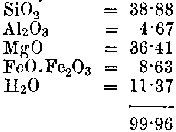No CrossRef data available.
Published online by Cambridge University Press: 01 May 2009
The name serpentine has been applied by many authors with so much vagueness that it appears to me desirable to lose no opportunity of examining any rock bearing this title, and to record briefly the result. A considerable number of patches of serpentine, generally of limited extent, are laid down on Ritter von Hauer’s Map of the Eastern part of the Alps, some of which also appear on that of Professor Theobald (sheet xx. of the Federal Map of Switzerland). Several of these I was able to examine, sufficiently for my purpose, during a visit to the district last summer.
page 538 note 1 In Prof. Theobald’s admirable monograph, Geol. Beschreib. von Graubünden, we find (p. 40), after he has admitted that there is much to favour the view of serpentine being an eruptive rock, the following statement: “Es möge der Serpentin eine letzte Stufe vom Umwandlung anderer Gesteine, Gabbro, Hornblendefels, Diorit, und selbst Schiefergebirgs sein, wie schon Studer bemerkt.”
page 540 note 1 The following analysis is given by Prof. Theobald of a serpentine from Marmels:

As there is no CaO in the analysis, probably the specimen did not contain augite, but had some spinel.